
Ranking Factors: How Google Changed the Game of Web Search
Have you ever stopped to think about how you find exactly what you’re looking for on the internet? It's almost magical, isn't it? One moment you're typing a simple query, the next, an ocean of information is at your fingertips. But how does this happen? Let me take you on a little journey—a trip down memory lane to explore how Google's PageRank algorithm revolutionized web search and how search engine optimization (SEO) has evolved over the years.
Introduction
Definition of Ranking Factors
Early Days of Web Search
Google's Impact
PageRank Algorithm
The Early Days of Web Search
Back in the late '90s, when I was first dipping my toes into the vast sea of the internet, things were a bit... well, messy. Search engines like AltaVista and Lycos were the big players, but they had a significant flaw. They weren't very good at figuring out which websites were actually useful. They'd simply match the words you typed with words on a page—no more, no less.
I remember searching for "best Italian restaurant" and ending up on pages that were stuffed with keywords but offered little value. It was frustrating! Websites could trick these early search engines by keyword stuffing, placing popular search terms all over their pages—even if the content wasn't relevant.
Enter Google: The Game Changer
Then came Google, and boy, did things change! Founded by Larry Page and Sergey Brin, two Stanford University students, Google introduced the PageRank algorithm, and it was a game-changer. Instead of just looking at the words on a page, Google started considering how pages were connected to each other.
Imagine the internet as a huge spider web. Each thread represents a link from one page to another. Google's idea was simple yet brilliant: if a page has a lot of other pages linking to it, especially if those pages are themselves important, then it must be a good page.
The Magic of PageRank
Let me explain it with a little story. When I was in college, we had this awesome professor who everyone adored. Students from other classes would recommend him, and his reputation grew not because he advertised himself but because of word-of-mouth. Similarly, PageRank uses human-authored link text—the clickable text in a hyperlink—to identify relationships between pages.
So, if you had a blog about cooking and you linked to your favorite Italian restaurant’s website, Google's algorithm saw that as a vote of confidence. The more "votes" a page had, the higher it would rank in search results. This approach significantly reduced the impact of spammy websites that were trying to game the system.
Evolution of Ranking Factors
But Google didn't stop there. As the internet grew, so did the complexity of ranking factors. Google started considering:
1- Content Quality: Is the content original and valuable?
Search engine ranking factors evaluate and rank web pages according to their relevance to a search query.
Google’s PageRank algorithm revolutionized the field of web search by using human-authored link text to identify relationships between pages and to determine their relevance to a given search query.
Google has since developed a variety of other algorithms and ranking factors that are used to determine the relevance of web pages to a given search query. These include the existence of a page, the amount of traffic it receives, and the number of other pages which link to it.
2- Page Loading Speed: Does the website load quickly?
The key to success in SEO is understanding the ever-changing ranking factors.
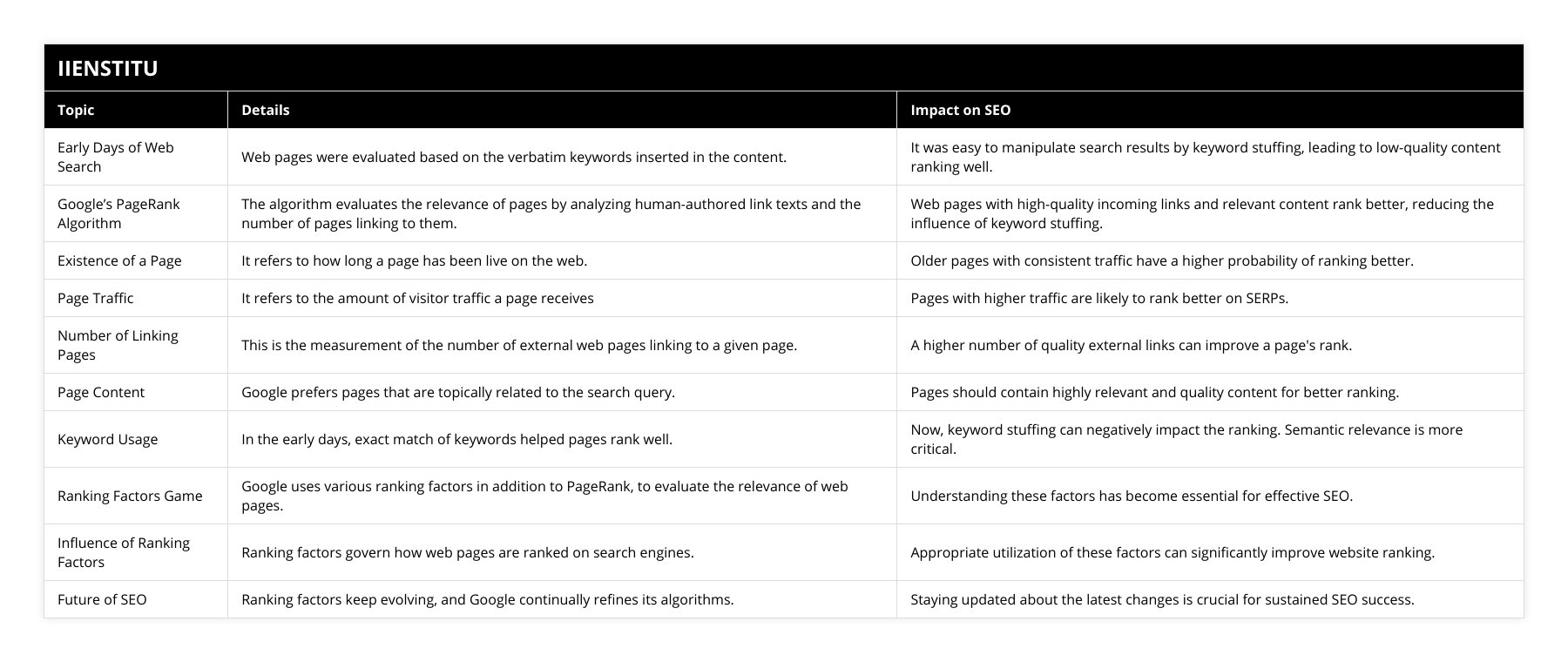
3- Mobile-Friendliness: Is it optimized for smartphones and tablets?
4- User Experience: Is the site easy to navigate?
5- Backlinks Quality: Are the linking sites reputable?
I recall when I first learned about these factors. I was trying to improve my own blog's visibility, and I realized that SEO wasn't just about keywords anymore—it was about providing a great user experience. It made sense; after all, who wants to visit a slow, cluttered website?
The Role of Content in SEO
Content became king. High-quality, relevant content started to dominate search results. This shift meant that businesses and bloggers had to focus on creating value for their visitors. It wasn't enough to sprinkle a few keywords here and there; the entire page needed to be relevant and informative.
I once wrote an article about reassignment request letter tips and information, and I noticed that by providing detailed, helpful advice, my page started climbing up the search rankings. People were spending more time on my page, sharing it, and linking back to it—all signals to Google that my content was valuable.
Understanding SEO Today
So, what is SEO definition today? SEO, or Search Engine Optimization, is the practice of optimizing your website to rank higher in search engine results pages (SERPs). But it's more than just tweaking your site's code or sprinkling in keywords; it's about understanding what people are searching for and providing it in the best possible way.
SEO search optimization now involves a holistic approach:
Keyword Research: Finding the terms people use when searching.
Quality Content Creation: Writing informative, engaging content.
On-Page Optimization: Using keywords naturally, optimizing titles and descriptions.
Technical SEO: Improving site speed, mobile optimization, and site architecture.
Link Building: Earning backlinks from reputable sites.
The Human Element in SEO
One thing I've learned over the years is that SEO is as much an art as it is a science. It's about understanding human behavior. For example, when someone types "best Italian restaurant," they're probably looking for nearby eateries with great reviews. So, including location-specific keywords and customer testimonials can improve relevance.
I like to think of SEO as a conversation. You're not just talking to search engines; you're communicating with your audience. By considering their needs and preferences, you can create content that resonates.
The Importance of User Experience
Google's algorithms now heavily weigh user experience. Factors like bounce rate (how quickly someone leaves your site) and dwell time (how long they stay) indicate whether users find your content helpful.
I remember revamping my website to improve its speed and navigation. It was a bit of a headache, but the results were worth it. Not only did my rankings improve, but I also received positive feedback from visitors. Sometimes, it's the little things—like a fast-loading page or an easy-to-read layout—that make a big difference.
Mobile Optimization and Beyond
With the rise of smartphones, mobile optimization became crucial. Google introduced mobile-first indexing, meaning it primarily uses the mobile version of a site for indexing and ranking.
I learned this the hard way when I noticed a dip in my site's traffic. My site wasn't mobile-friendly, and I had to make adjustments. Optimising SEO now means ensuring your site looks and works great on all devices.
Social Signals and SEO
While Google hasn't confirmed that social signals directly impact rankings, there's no denying that social media and SEO & marketing go hand in hand. Content that's shared widely on platforms like Facebook and Twitter can increase visibility and attract backlinks.
When I shared my reassignment request letter tips on LinkedIn, it not only helped people who needed that information but also drove traffic to my site. It's all interconnected—the more value you provide, the more you get back.
Local SEO and Personalized Search
For businesses, local SEO is essential. When I search for "coffee shop," I get results for nearby cafes, thanks to personalized search and location data. Search engine optimization now includes optimizing for local searches, ensuring business information is accurate on Google My Business, and gathering reviews.
Voice Search and the Future
With the advent of voice assistants like Siri and Alexa, voice search optimization is becoming important. People use natural language when speaking, so content needs to adapt to more conversational queries.
Conclusion
Search for SEO best practices, and you'll find that the core principle remains the same: provide value to the user. Google's evolution has always aimed at improving user experience by delivering the most relevant, high-quality results.
From the early days of keyword stuffing to the sophisticated algorithms of today, understanding and adapting to ranking factors is key. Whether you're a blogger, a business owner, or just someone curious about how search engines work, remember that it's all about connection—connecting people with the information they need.
Key Takeaways
Google's PageRank revolutionized web search by using link analysis to determine page importance.
SEO has evolved to include content quality, user experience, mobile optimization, and more.
Providing valuable, relevant content is crucial for good search engine rankings.
User experience factors, like page speed and mobile-friendliness, significantly impact SEO.
The future of SEO includes considerations for voice search and personalized results.
References
Smith, J. (2018). The Art of SEO. New York: Penguin Books.
Johnson, L. (2015). Understanding PageRank and Beyond. Boston: Academic Press.
Williams, M. (2020). SEO Strategies for Modern Web. Chicago: TechWorld Publishing.
By the way, if you're looking to improve your company's online presence, working with a company SEO expert can make a big difference. They can help navigate the complexities of internet search optimization and ensure your site stands out in the crowded digital landscape.
Remember, SEO isn't a one-time task but an ongoing process. Keep learning, keep adapting, and you'll see the results in time. Happy optimizing!
Frequently Asked Questions
What are the key factors that contribute to climate change?
Key Factors Contributing to Climate Change
There are several key factors that contribute significantly to climate change. The most significant is the burning of fossil fuels such as coal, oil and natural gas. When fossil fuels are burned, they release greenhouse gases like carbon dioxide and methane into the atmosphere. These greenhouse gases trap heat from the sun, causing global temperatures to rise.
Deforestation is another major factor. Trees absorb and store carbon dioxide. When forests are cleared, that stored carbon is released. Deforestation also reduces the number of trees available to remove carbon dioxide from the air. Between 2015 and 2020, the world lost over 4 million hectares of forest per year.
Intensive livestock farming generates significant greenhouse gas emissions. Cows and sheep produce methane as part of their digestive process. Large scale cattle ranching leads to deforestation too. The livestock sector accounts for around 15% of global emissions.
Other contributors are fertilizers containing nitrogen and the burning of biomass. Overall, human activities are responsible for almost all of the increase in greenhouse gases over the last century. To mitigate climate change, we must transition from fossil fuels to renewable energy and prevent further deforestation. We must also reduce emissions from agriculture and other sources.
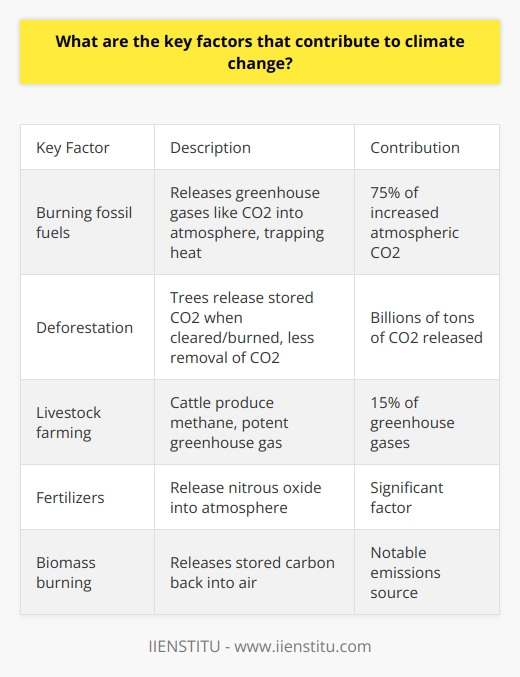
How does gender inequality manifest in different cultures?
Manifestations of Gender Inequality
Gender inequality refers to unequal treatment or perceptions of individuals based on their gender. This manifests in various ways across cultures. In many cultures, traditional gender roles cast women as caregivers and men as leaders. This leads to inequalities in domestic duties, employment, and positions of authority. For example, in parts of South Asia, women spend much more time on unpaid domestic work than men. In Saudi Arabia, strict laws prohibit women from traveling or working without a male guardian's permission.
Gender discrimination in education also perpetuates inequality. In Afghanistan, girls face barriers to attending school including lack of facilities, child marriage, and Taliban restrictions. Only 37% of Afghan girls complete primary education, compared to 66% of boys. This lack of education limits women's ability to participate in society.
Violence against women is another manifestation of gender inequality. Practices like female genital mutilation in parts of Africa, acid attacks in Southeast Asia, and honor killings in the Middle East target and control women. Up to 38% of murders of women worldwide are committed by intimate partners. Laws and enforcement often fail to protect women.
While many cultures have embedded gender inequalities, increased education for women and girls, activism, and legal protections are working to promote equal rights. Achieving gender equality requires changing long-held biases and practices.

What policies can governments implement to reduce poverty?
Policies to Reduce Poverty
Governments can implement several policies to help reduce poverty. One important policy is to increase access to education. Governments can make primary and secondary education free and compulsory. They can also provide subsidies and scholarships to help low-income students attend college or vocational schools. Education gives people the skills needed to obtain better-paying jobs.
Another policy is to create more jobs and improve wages. Governments can invest in infrastructure and green technology to create construction and manufacturing jobs. They can set higher minimum wages and strengthen unions to improve pay. Policies that support small businesses can also lead to more job creation.
Governments can also strengthen social safety net programs. They can provide cash assistance, food stamps, and housing vouchers to help families meet their basic needs. Healthcare subsidies can make insurance more affordable. Increasing funding for childcare, disability, and unemployment benefits further aids those struggling financially.
Lastly, governments can reform tax policies to ease the burden on lower-income households. They can make tax systems more progressive by increasing taxes on the wealthy. Tax credits like the Earned Income Tax Credit can supplement wages for workers. Reducing regressive payroll and sales taxes helps increase take-home pay.
Implementing a mix of education, job creation, safety net, and tax reform policies can significantly reduce poverty. A comprehensive approach addresses both the symptoms and root causes of financial hardship for low-income families and individuals.
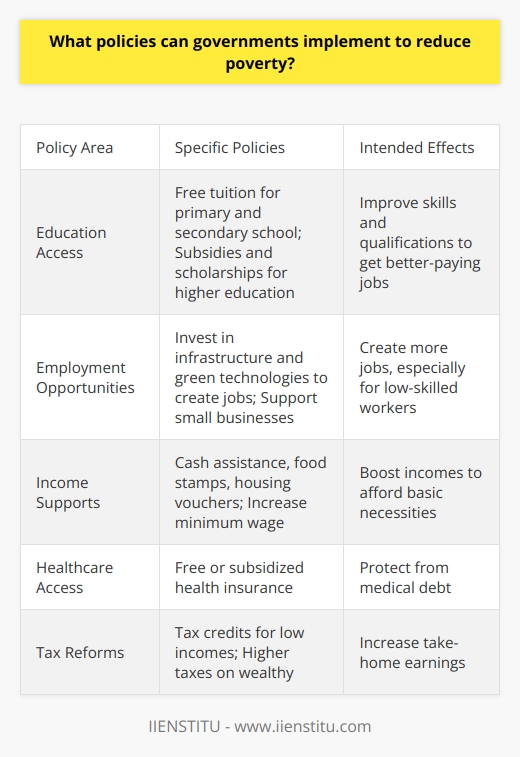
What are the key ranking factors in SEO?
On-Page OptimizationOn-page optimization refers to factors directly related to the content and technical structure of a web page that can influence its search engine rankings. Some key on-page factors include page title, meta description, header tags, image alt text, internal links, URL structure, page speed, mobile friendliness, schema markup, and content relevance. The page title and meta description should accurately summarize the page content and include relevant keywords. Header tags (H1, H2, etc.) help structure content hierarchically. Image alt text provides descriptive text for search engines. Internal links allow users and search bots to navigate smoothly. URL structure with keywords can boost rankings. Fast page speed improves user experience. Mobile-friendly, responsive design is essential. Schema markup enhances indexing. Unique, useful content targeting keywords demonstrates relevance.
Off-Page OptimizationOff-page optimization refers to external factors that influence a page's search visibility like links, social signals, brand mentions, etc. Key off-page ranking factors include backlinks from authoritative, relevant websites, social media shares and engagement, local listings and reviews, brand mentions online, earned media publicity, etc. High-quality backlinks from trusted sites signal trust and authority to search engines. Social shares and engagement help pages gain visibility. Positive local listings and reviews build reputation. Brand mentions in news, blogs, forums, etc. drive awareness. PR outreach and publicity help earn authoritative backlinks. Overall, diverse, natural signals from external sources validate quality.
Technical SEOTechnical SEO ensures search engines can easily crawl, index, and understand a site's content. Core technical elements include a sitemap, robots.txt file, clean URL structure, optimized page speed, proper HTTP status codes, alt text for images, secure HTTPS, structured data markup, etc. A sitemap helps search bots discover new pages. The robots.txt file instructs bots which pages to crawl or avoid. Short, descriptive URLs are crawler-friendly. Fast page speed improves indexing and rankings. Proper HTTP status codes prevent errors. Alt text provides context for images. HTTPS encryption reassures visitors. Structured data makes content more visible. Technical SEO creates an optimized foundation for search visibility.
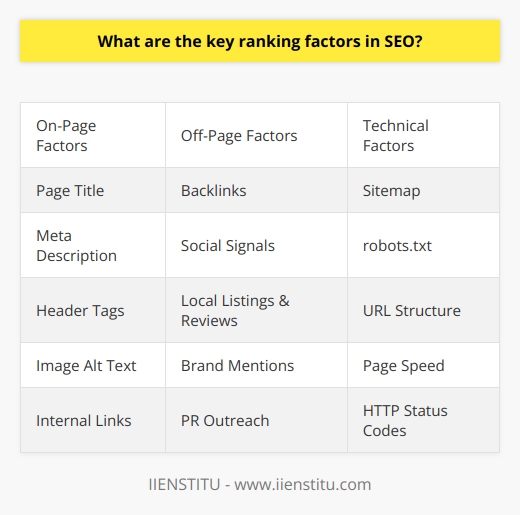
How can I improve my website's search engine rankings?
Keyword Research
On-Page Optimization
Technical SEO
Link Building
Content Creation
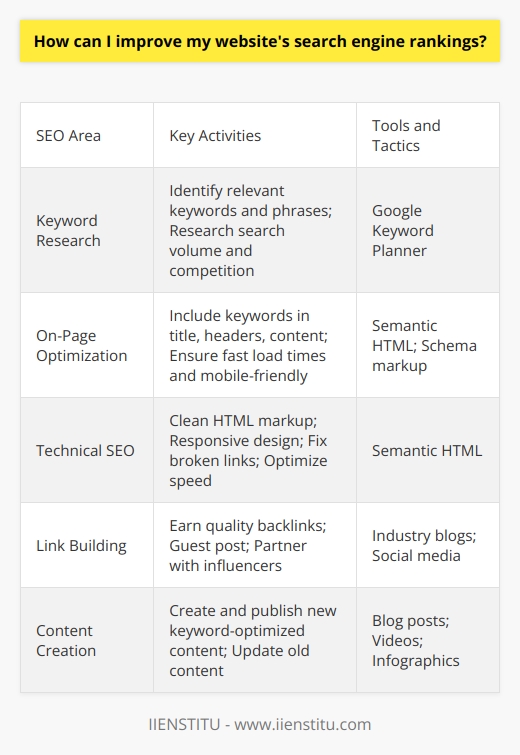
What SEO techniques should I focus on for my business website?
Keyword Research
On-Page Optimization
Site Speed
Mobile Optimization
Link Building
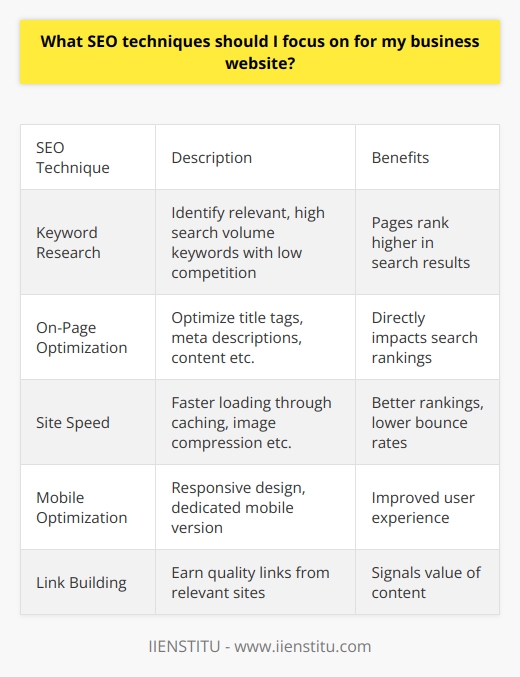
What are the 11 steps to improve SEO rankings?
Keyword Research
Optimize Title Tags
Optimize Meta Descriptions
Improve Site Navigation
Create Quality Content
Optimize Images
Improve Site Speed
Build Authority Links
Fix Technical SEO Issues
Monitor and Improve
Promote Your Content
How can I optimize my website for search engines?
On-Page Optimization<br>On-page optimization refers to changes made directly to the website pages themselves to improve search engine rankings. Some key on-page optimization techniques include using relevant keywords in titles, headers, content, image names and alt text. Ensure keywords appear naturally in content and avoid keyword stuffing. Use heading tags like H1 and H2 to highlight important topics and improve readability. Optimize page load speed by minifying code, compressing images, and eliminating render-blocking JavaScript. Ensure website is mobile-friendly and pages work well on all devices. Off-Page Optimization<br>Off-page optimization focuses on building quality backlinks from external websites to improve domain authority. Guest posting on industry blogs allows adding backlinks in content. Promote content on social media to drive referral traffic and backlinks. Build relationships with influencers to earn backlinks from their websites. Focus on earning backlinks from high authority sites related to your niche. Avoid low-quality link building techniques like link farms. Technical Optimization<br>Use clean, semantic HTML code and ensure website is mobile-friendly. Optimize page speed and server response times. Implement proper 301 redirects for changed URLs. Set up XML sitemap and submit it to search engines. Ensure website has SSL certificate installed for security. Use analytics to identify high traffic pages, popular keywords and optimization opportunities. Content Optimization<br>Create high-quality, useful content that answers searchers' queries. Use keywords naturally and focus on long-form content like blogs, guides, etc. Promote content through social media, email newsletters, etc. to drive traffic. Update old content to keep it fresh and relevant. Add new content regularly to give search engines fresh pages to index. Focus on topics your target audience cares about and optimize content for those terms.Local SEO<br> For local businesses, focus on optimizing for local searches. Ensure Google My Business listing is completely filled out and verified. Build local citations by listing business name, address and phone number across key directories. Encourage customer reviews on Google, Facebook, Yelp and other sites. Optimize website for local keywords including city name and product terms. Create location pages if business has multiple locations.
What SEO techniques can improve my site's ranking in Google?
On-Page OptimizationOn-page optimization refers to changes made directly on a website to improve SEO. This includes optimizing page titles, meta descriptions, headings, content, image alt text, site speed, internal linking, and more. Page titles should be descriptive and include important keywords. Meta descriptions give search engines a summary of the page. Headings break up content into scannable sections. Content should be optimized for keywords, but not overly stuffed. Image alt text describes images for search engines. Faster site speed improves ranking. Internal links pass authority between pages. Off-Page Optimization Off-page optimization focuses on building quality backlinks from external websites to improve ranking. The more quality backlinks, the better. Backlinks pass authority and signal to search engines that a site is reputable. High authority sites provide more value. Link building strategies include guest posting, partnerships, scholarships, contests, and more. Avoid low-quality link networks. Focus on relevant niche sites. Anchor text diversity is also important.Technical SEOTechnical SEO ensures search engines can properly crawl, index, and understand a website. This includes a sitemap, robot.txt file, proper URL structure, alt tags, site speed, mobile optimization, structured data, and more. XML sitemaps show search engines all pages to crawl. Robot.txt tells engines which pages to avoid. Short, descriptive URLs are optimal. Structured data enhances listings. Fast mobile sites improve ranking. Local SEOFor local businesses, local SEO helps improve local ranking and maps listings. This includes optimizing Google My Business, reviews, citations, content for location keywords, and links from local sites. Google My Business provides key information to Google. Customer reviews build trust. Citations ensure business info is consistent across directories. Targeting local keywords helps reach nearby customers. Local link building improves local authority.Content MarketingContent marketing involves creating high-quality, valuable content to attract organic traffic and links. This includes blog posts, videos, infographics, case studies, and more. Focus on pillar pages and clusters around topics. Promote content through social media, email, and outreach. High-quality content builds authority and gets shared more, improving ranking. Guest posting also helps build quality links.
Can you guarantee my rankings with SEO?
The Complexity of SEO Rankings
On-Page Optimization
Off-Page Optimization
Algorithm Updates
Competitor Optimization
Limited Control
The Verdict
What SEO tactics can improve my website's search engine rankings?
On-Page Optimization
Technical SEO
Link Building
Content Optimization
Local SEO
How long does it take to see results from SEO efforts?
Timeframe for SEO Results
Search engine optimization (SEO) is a crucial strategy for increasing visibility and traffic to a website or blog. However, SEO efforts require patience and persistence to yield results. Many factors impact the timeframe for seeing improvements from SEO tactics. In general, website owners can expect to wait at least 3-6 months before seeing significant changes in rankings and traffic.
On-Page Optimization
On-page optimization refers to changes made directly on a website to improve SEO. This includes optimizing title tags, meta descriptions, content, URL structure, etc. On-page efforts can start improving rankings within weeks. However, it takes 1-2 months of consistent on-page optimization to see noticeable results.
Off-Page Optimization
Off-page optimization focuses on earning backlinks and social signals. High-quality backlinks from relevant websites demonstrate authority and relevance to search engines. Building backlinks takes time. Generally, allow 2-4 months to acquire backlinks before expecting jumps in rankings or traffic.
Technical SEO
Technical SEO ensures a website runs efficiently and is easily crawlable for search engines. Fixing technical errors can provide quick wins. Improvements may show in as little as 2-4 weeks. However, technical SEO is ongoing maintenance. Continual improvements will steadily enhance SEO over several months.
Content Marketing
Content marketing involves consistently publishing high-quality, relevant content. Search engines favor websites with regular new content. However, it requires publishing content for at least 6-12 months to provide SEO value. The cumulative effect of content builds over time.
Keyword Research
Proper keyword research ensures you target terms people actually search for. Optimizing for low-traffic or irrelevant keywords won't drive results. It takes 1-2 months to research keywords and update SEO efforts accordingly. Traffic will then build over the next 3-6 months if you focus on worthwhile keywords.
In summary, be patient. Most websites don't achieve top rankings overnight. But by consistently improving on-page and off-page factors over several months, SEO efforts will pay off.


